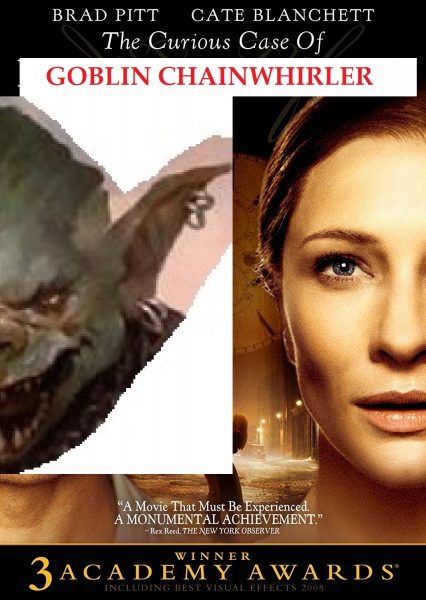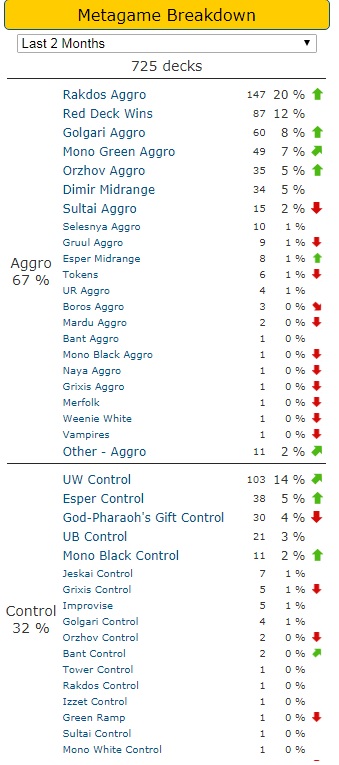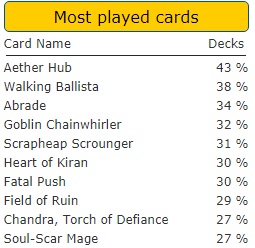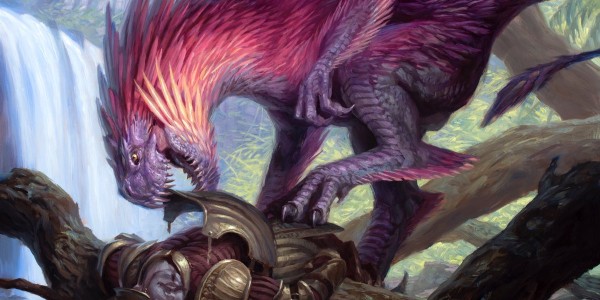Are you a Quiet Speculation member?
If not, now is a perfect time to join up! Our powerful tools, breaking-news analysis, and exclusive Discord channel will make sure you stay up to date and ahead of the curve.
Welcome back, readers!
Today's article title is pretty spot on. We will be looking at the curious case of Goblin Chainwhirler.

Obviously my years of MS Paint expertise has come in handy here, so if you can't tell, that's not actually Brad Pitt.
All joking aside, the reason for this article is that the updated banned and restricted list came out when I was on my honeymoon cruise (and had almost no internet), on July 2nd.

I was really surprised to see Legacy bans (let alone two of them), but I figured the card that dodged the biggest bullet in Standard—Goblin Chainwhirler—would see a price spike.
But it didn't. If we look at the retail price over time we see that it dropped prior to the B&R announcement (for fear of it getting banned), but no rebound once it cleared that hurdle.
We have seen a dramatic shift in the speed of marketplace correction in the world of MTG finance in the past few years. It used to be that you could pick up cards that were recently unbanned at the old price a day after—now you have an hour or two if you're lucky. So why, six days after this card dodged a banning, is it still trending downward?
Today I'd like to explore some possible answers to that question.
Did the Metagame Shift?

According to MTGTop8.com, we still have Mono-Red and Rakdos Aggro accounting for a full 32% of the metagame. This would imply that red-based aggro strategies are still very prevalent, accounting for the #1 and #3 spot for most played decks online. We have very limited data on major events that have occurred since the B&R announcement. However, as there were no changes to Standard, it seems fair to expect the pre-B&R metagame to mirror the post B&R metagame.
Has the Card Fallen Out of Favor?

Chainwhirler takes up the #4 spot of most played cards, at a full 32%—you are likely to face an opponent playing it almost one out of every three matches you play in. Just as importantly, after reviewing various decklists, I can say it's played as a four-of almost all the time.
So with clear "no's" to these first two questions, why is the price still trending downward?
A Fear of Future Banning?
A recent article on TCGplayer discussed the dangers of Goblin Chainwhirler in Standard. I discussed the card's power with friends whose opinions I value a fair amount, and they also expected it to be banned. Their argument was that if WotC felt Rampaging Ferocidon was too powerful for Standard because it hosed token strategies (which is pretty much the entire Vampire tribe from Ixalan block), than surely a card that is better overall and arguably more powerful against those strategies would be as well. I think that's a very fair argument to make.
While most would agree that Goblin Chainwhirler is a better card than Rampaging Ferocidon in terms of overall power level, the key difference is the mana cost. Chainwhirler (and the whole cycle of creatures with triple-mono-colored mana costs) are extremely difficult to splash. You can see this is the composition of the Rakdos Aggro, which tends to play zero Swamps and 10-12x Mountains.
When you play mostly mono-colored decks (even with the splash), you are limited in solution cards to problems you might face. The black splash allows for some non-burn-based removal in Unlicensed Disintegration, as well as hand disruption against control decks. Losing access to these tools is a serious drawback.
Another element to consider is that WotC has had a lot of Standard bans in the past few years. In fact there are likely a significant number of players who don't realize how out of the norm Standard bans actually are when you look throughout Magic's history.
If we travel back to the infamous 2011 Jace, the Mind Sculptor and Stoneforge Mystic bannings, WotC hadn't banned a card in Standard for over six years prior to this announcement. They even caved a bit and allowed players who had purchased the War of Attrition event deck (which contained two copies of Stoneforge) to play it in Standard events so long as they didn't modify the deck.
Why do I bring this up? Because it is vitally important for WotC to maintain and grow the Magic playerbase in order to meet sales quotas that, in all likelihood, are ever increasing. There are a few easy ways to lose players:
- An unfun metagame. This can occur when a small number of decks dominate it to the point that it becomes stagnant (see Caw-Blade era).
- The cards themselves are unfun. This can occur when players don't actually feel like they get to play the game (see Combo Winter back in 1999).
- Cards that players have recently acquired are banned. This is at the opposite end of the "Ban/Not-Ban spectrum," but it's still important. People naturally feel more pain at a loss than a gain of equal value, and having their cards banned can easily drive someone away from the game. Personal case in point: I haven't played much Legacy since they banned Sensei's Divining Top, and my overall love of the format diminished after that banning.
Moving Forward
(I'm not sure on the legacy aspects, as my opinion is that unless a deck is so dominant in the format that it eliminates most competitors they should leave it alone; as the barrier of entry to the format is so high that the "loss" of a deck will easily drive players away).
I actually think WotC played this B&R announcement wisely with respect to Standard (I'm less sure on the Legacy aspect). By not banning Goblin Chainwhirler, WotC is allowing the Standard format to change organically rather than force it through a ban.
We are already seeing a metagame shift with the control decks. At US Nationals (the last large-scale tournament I can find any data on, which occurred prior to the B&R announcement), six of the Top 8 decks were Chainwhirler-free, including three UB Control variants we hadn't seen before.
Interestingly enough, these UB decks look as though they should have difficulty with fast aggro variants, as many lack any form of sweeper, instead looking to rely on cheap one-for-one removal until they can land The Scarab God or Torrential Gearhulk and turn the corner. If these decks are viable, than the red-based aggro decks are a bit slower than previous iterations, and we will likely see a shift away from those archetypes.
That being said, we have already entered the pre-rotation slump in anticipation of Kaladesh and Amonkhet blocks leaving in the fall. Speculating on cards from these sets in hopes of short-term spikes is extremely risky. I would avoid cards in the UB Control decks as they lose both their current haymakers in the fall.
I would rather look at cards that will remain in Standard post-rotation, and that match up well against Goblin Chainwhirler should we see a resurgence in Mono-red in the future.
My favorite anti-Chainwhirler spec is Ripjaw Raptor, which has a high enough toughness to go toe-to-toe with Chainwhirler and live to fight another day. Its enrage trigger is fantastic against any deck relying on damage-based removal, and green midrange decks that would likely play a card like this will overload the red-black variants' limited non-damage based removal spells (i.e. Unlicensed Disintegration).
In fact, I am a fan of the enrage mechanic in general as a good solution to the Chainwhirler menace, as it turns the ETB ability into a potential liability.
While this card doesn't have any enrage triggers on it, it's a very efficient beater that survives Chainwhirler's ETB effect. It can beat a 3/3 first striker in combat (barring outside assistance) and it's on curve—if your opponent is on the play and drops a turn-three Chainwhirler, you can drop a Brontodon immediately and brickwall it.
Likely our premier cheap removal spell of the format once Fatal Push rotates out, I really like Cast Down moving forward. It was likely included in Dominaria as a complement to all the powerful legendary creatures in the set. Several months after release we are seeing very few of them show up in Standard decklists, which means its limitations as a spec are minimal at this time.









Another reason Goblin Chainwhirler survived the ban is the looming Standard rotation will deprive red of several creatures (Hazoret, Chandra, Bomat, Kari-Zev, Khenra, and Ahn-Crop), so WotC wants to see if red can survive post-rotation before it deprives it of an additional creature. With Rampaging Ferocidon, it was a card in a fresh Ixalan block with no rotation in sight, so WotC knew they needed to take that bull by the horns. I wonder if some red players are scared red might not have a future post-rotation, which could further explain Goblin Chainwhirler’s declining price. We’ll see.
Regarding WotC’s concerns on stale meta’s, I’m noticing one method to resolving this is they’re releasing several one-dimensional planeswalkers. Jaya uses heavy spells, new Liliana uses zombies (in all her abilities), Sarkhan piggybacks off Dragons, Tezzeret and his artifacts, etc. The number of these has increased. WotC is trying to segregate players into tribal camps — the Ixalan block attests to this. From a financial perspective, it’s hard to spec on these; we need Planeswalkers that are plug-and-play, such as LotV and JtMS. It’s no surprise then Teferi is the MVP of the set.
Thanks for the response. That is definitely a good argument towards not getting banned. It still blows my mind that it’s price is so low given its dominance. It feels like everyone is so bearish on it getting banned and flat out ignoring the rsults.
I also agree with you on the walkers. I don’t mind the more focused take on walkers simply because they serve as a continual source of advantage so that advantage is kept in check with these limitations.